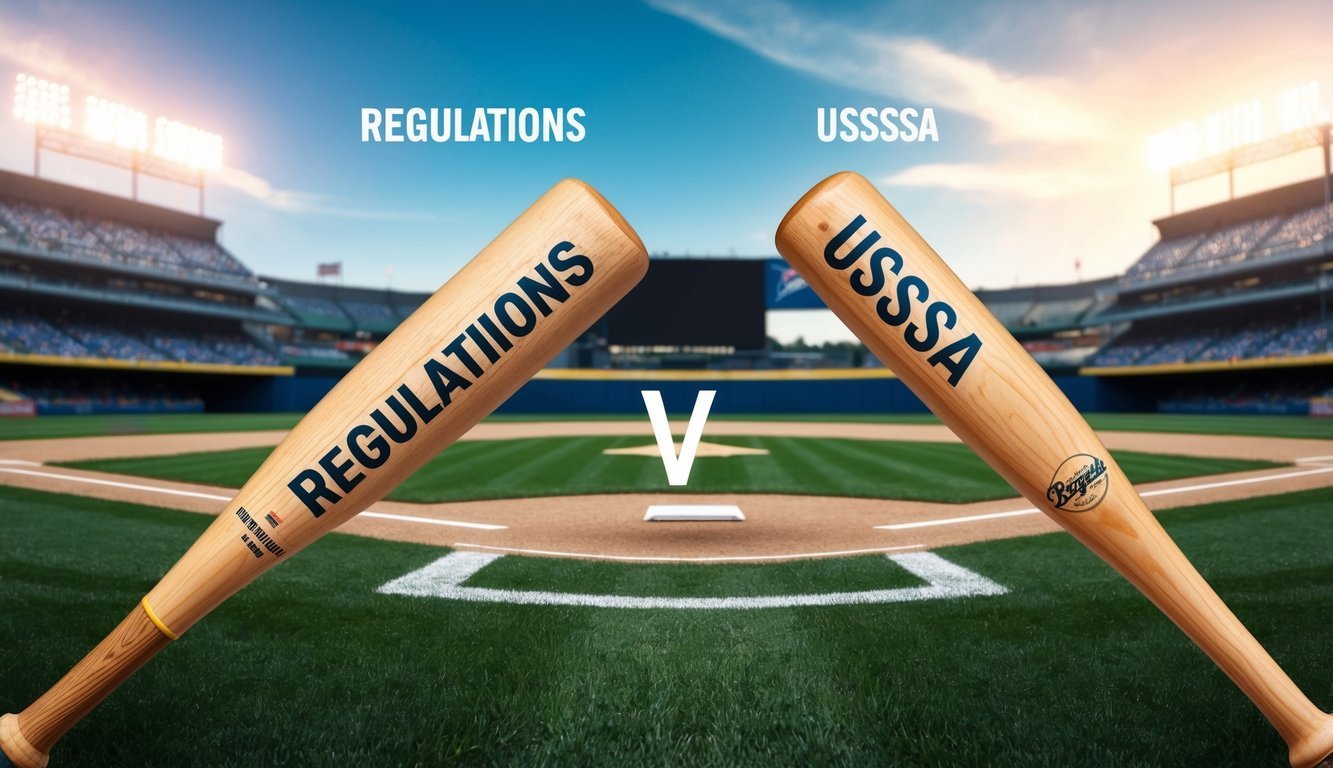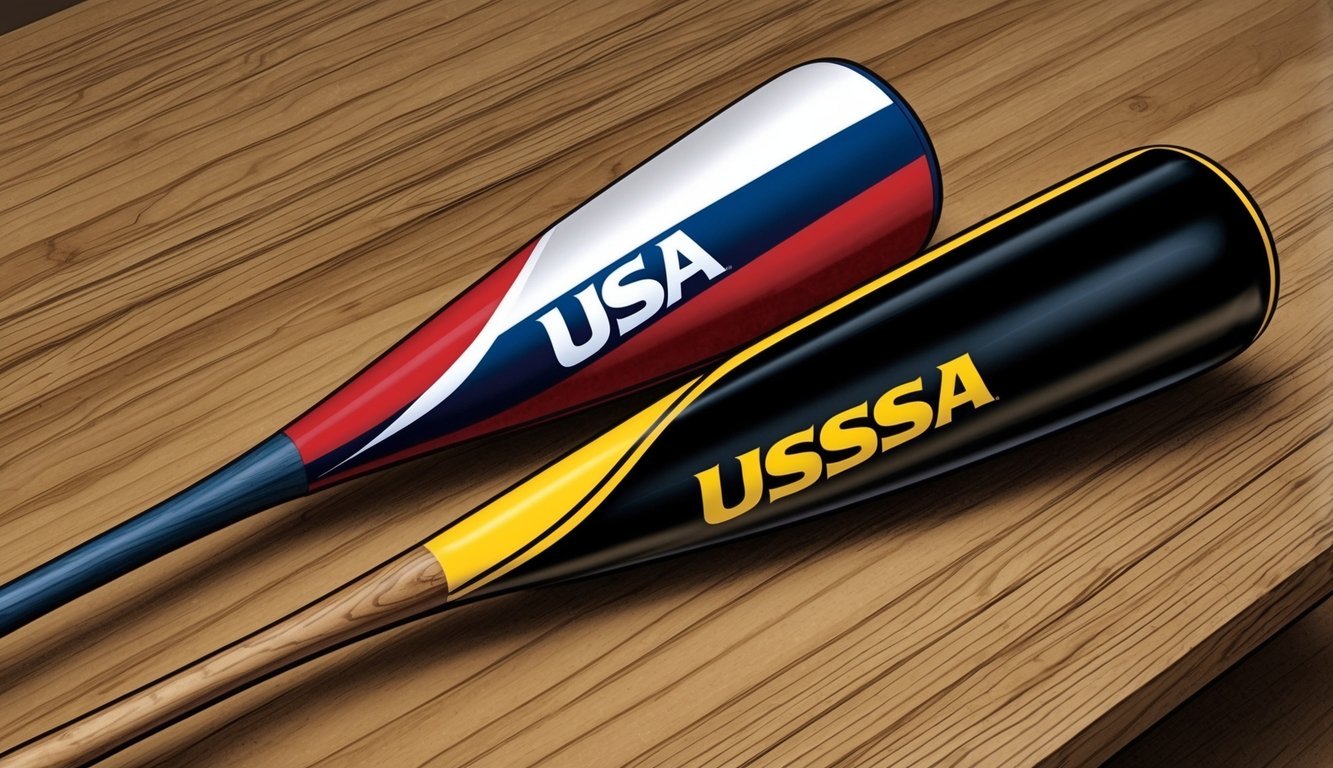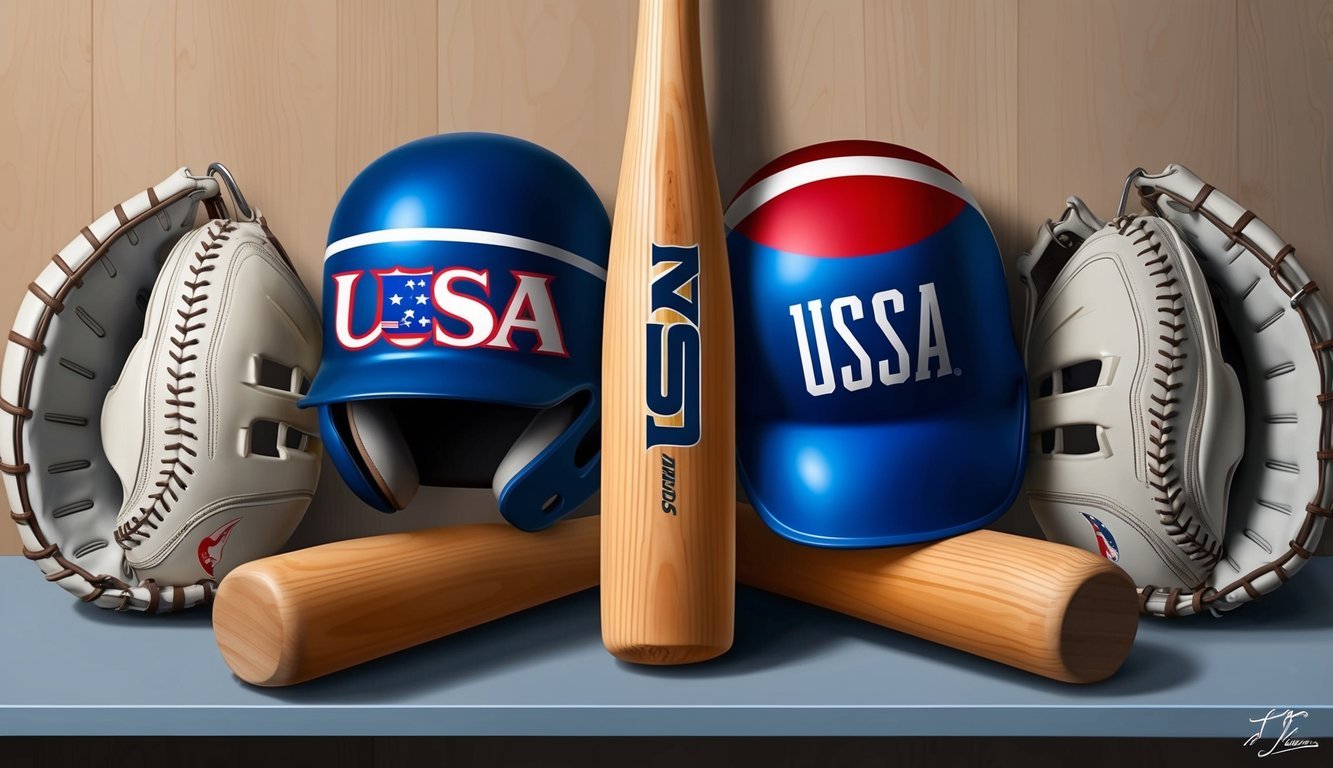When choosing a baseball bat, players often find themselves deciding between USA and USSSA bats.
These two standards have distinct characteristics that cater to different leagues and player preferences. USA bats are designed to mimic wood-like performance and are mandatory in many youth leagues.
Meanwhile, USSSA bats offer higher performance and are used in travel ball and other competitive leagues.
The main differences between USA and USSSA bats lie in their barrel diameters, performance standards, and weight drops.
USA bats have a maximum barrel diameter of 2 5/8 inches, whereas USSSA bats can go up to 2 3/4 inches.
This difference affects the size of the sweet spot and the overall feel of the bat during swings.
Weight drops also vary between the two types, with USA bats offering options up to -11 and USSSA bats extending to -12.
This means USSSA bats can potentially be lighter, which may benefit younger players still developing their swing mechanics.
Understanding these differences can help players and parents make informed decisions when selecting the most suitable bat for their needs and league requirements.
Understanding Baseball Bats
Baseball bats come in different types designed for specific leagues and age groups.
The choice between USA and USSSA bats impacts player performance and safety on the field.
Baseball Bat Basics
Baseball bats are essential equipment for hitting.
They’re typically made of wood, aluminum, or composite materials.
Wood bats are classic and used in professional leagues, while metal and composite bats are popular in youth leagues.
Bats have several key parts:
- Knob: The bottom end
- Handle: Where players grip the bat
- Barrel: The hitting surface
- End cap: Covers the top of the barrel
Bat length and weight are crucial factors.
Players should choose a bat they can comfortably swing.
A common rule is to hold the bat by the barrel – if you can easily lift it with your arm extended, it’s a good fit.
Different Leagues, Different Bats
Youth baseball leagues have specific bat regulations.
The two main standards are USA Baseball and USSSA.
These regulations ensure that equipment is safe and suitable for younger players, promoting fair competition.
Understanding these standards is crucial not only for compliance but also for recognizing the evolution of the sport, which includes significant milestones like the integration of various communities into baseball, a rich topic intertwined with negro leagues baseball history.
By appreciating these regulations, players and coaches can foster a deeper connection to the game and its diverse heritage.
USA Baseball bats:
- Max barrel diameter: 2 5/8 inches
- Designed to mimic wood bat performance
- Used in Little League, Babe Ruth, PONY, AABC, and other youth leagues
USSSA bats:
- Max barrel diameter: 2 3/4 inches
- Higher performance level
- Used in USSSA tournaments and some travel ball leagues
Little League adopted USA Baseball standards in 2018 for safety reasons.
USSSA bats generally offer more “pop” and are favored by more advanced players.
Always check your league’s specific bat requirements before making a purchase.
USA vs USSSA Bats
Baseball players and parents often face a choice between USA and USSSA bats.
These two standards have key differences in design, performance, and intended use.
USA Bat Standards
USA bats are designed for younger players, emphasizing safety and wood-like performance.
They have a maximum barrel diameter of 2 5/8 inches, which is slightly smaller than USSSA bats.
USA bats can have drop weights up to -11, making them lighter and easier to swing for developing players.
This standard aims to provide a more natural transition to wood bats as players advance.
These bats are required in many youth leagues and Little League competitions.
They’re engineered to perform similarly across different brands, creating a more level playing field for young athletes.
USSSA Bat Standards
USSSA bats are typically used by older or more advanced players in travel ball and competitive leagues.
They allow for a larger barrel diameter of up to 2 3/4 inches, offering a bigger sweet spot.
The drop weight options for USSSA bats include -12, -10, -8, and -5, providing more variety for different player preferences and skill levels.
BBCOR-certified bats, which are also USSSA-approved, have a mandatory -3 drop.
USSSA bats are known for their enhanced performance and “pop” compared to USA bats.
This makes them popular among players looking to maximize their hitting potential in competitive settings.
Performance Differences
USA bats generally produce less trampoline effect, resulting in reduced exit velocities compared to USSSA bats.
This design choice prioritizes player safety and skill development.
USSSA bats, with their larger barrels and different performance standards, tend to generate higher exit velocities and potentially longer hits.
This can lead to more powerful offensive play.
• USA Bats:
- Wood-like performance
- Lower exit velocities
- Focus on player development
• USSSA Bats:
- Enhanced “pop”
- Higher exit velocities
- Larger sweet spot
Players and coaches should consider league requirements, player age, and skill level when choosing between USA and USSSA bats.
Each standard offers unique benefits tailored to different playing environments and developmental stages.
Regulations and Certifications

Baseball bat regulations and certifications play a crucial role in ensuring fair play and player safety.
Different governing bodies have established specific standards that bats must meet to be used in sanctioned competitions.
Certified Bats and Their Importance
Certified bats are essential for maintaining a level playing field in baseball.
USSSA bats must display a 1.15 BPF USSSA stamp on the taper between the handle and barrel.
This stamp indicates the bat meets USSSA performance standards.
USA bats, on the other hand, feature the USABat certification mark.
These bats are designed to perform more like wooden bats, promoting player development and safety.
BBCOR bats, primarily used in high school and college play, must have a certified .50 BBCOR stamp.
This certification ensures the bat’s performance is similar to that of a wooden bat.
Governing Bodies and Regulations
Various organizations oversee bat regulations in baseball.
USSSA, USA Baseball, and the National Federation of State High School Associations (NFHS) are among the key governing bodies.
USSSA maintains its 1.15 BPF standard, which has been in place since 2005.
Bats must not exceed 2 ¾ inches in barrel diameter and must be manufactured by an approved USSSA bat maker.
USA Baseball introduced the USABat standard to align youth baseball bat performance with professional wooden bats.
This standard aims to enhance player safety and skill development.
BBCOR regulations, enforced by the NFHS and NCAA, ensure bats perform similarly to wood, promoting a balanced game between offense and defense.
Physical Characteristics of Bats

USA and USSSA bats have distinct physical traits that impact their performance and suitability for different players.
These characteristics include weight, barrel size, and overall design.
Understanding Drop Weight
Drop weight refers to the difference between a bat’s length in inches and its weight in ounces.
USA bats typically have a wider range of drop weights to accommodate younger players.
They often come in -11, -10, or -8 options.
USSSA bats have more specific drop weight requirements.
Most USSSA certified bats have drop weights of -10, -8, or -5.
This narrower range caters to more advanced players who can handle heavier bats.
BBCOR bats, which are approved for high school and college play, must have a -3 drop weight.
This standardization aims to level the playing field and prioritize player skill over equipment advantages.
Barrel Size and Impact on Performance
Barrel size is a key differentiator between USA and USSSA bats.
USA bats have a maximum barrel diameter of 2 5/8 inches.
This size limit aims to mimic the performance of wooden bats, promoting safer play for younger athletes.
USSSA bats can have larger barrels, up to 2 3/4 inches in diameter.
This increased size creates a bigger sweet spot, potentially making it easier for players to make solid contact with the ball.
The larger barrel of USSSA bats often translates to improved performance.
It can result in higher exit velocities and longer hit distances compared to USA bats.
However, this performance boost comes with stricter regulations on eligible age groups and competitions.
Choosing the Right Bat

Selecting the ideal bat involves considering factors like age, skill level, and league requirements.
The right choice can significantly impact a player’s performance and enjoyment of the game.
Factors to Consider for Youth Bats
When picking a youth baseball bat, size and weight are crucial.
Bats that are too heavy can slow down swing speed, while those too light may lack power.
A good rule of thumb is to choose a bat length that reaches the player’s hip when placed on the ground.
Weight is equally important.
The “drop weight” (length minus weight in ounces) should match the player’s strength and hitting style.
Younger players often benefit from a lighter bat with a higher drop weight.
League regulations also play a role.
USA Baseball and USSSA have different standards, so it’s essential to check which certification is required for your league.
Travel Ball and Tournament Selection
Players often opt for USSSA bats for travel ball and tournaments due to their reputation for enhanced performance.
These bats typically have a larger sweet spot and more “pop,” which can be advantageous in competitive play.
USSSA bats are popular in elite tournaments like the USSSA World Series.
They’re designed to maximize hitting power and distance, making them a favorite among more experienced youth players.
However, some tournaments may require USA Baseball certified bats.
These bats prioritize safety and wood-like performance, so it’s crucial to consider age criteria and league rules.
Ultimately, the best bat for travel ball depends on the player’s hitting strength, tournament regulations, and personal preference.
Testing different options can help find the perfect match for optimal performance on the field.
